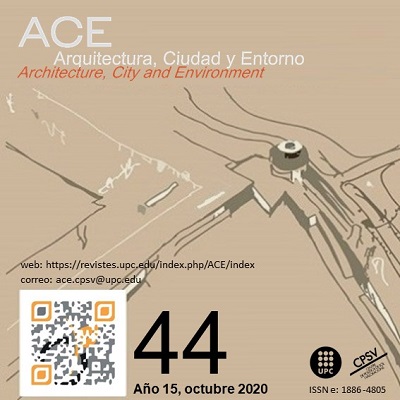Buildings in warm humid weather. Tampico, Tamaulipas case. Mexico
DOI:
https://doi.org/10.5821/ace.15.44.5667Keywords:
Thermal comfort, vegetation, solar radiation, windAbstract
The objective of this work is the analysis in short time and with internal resources, of the environmental behavior of Multifamily buildings, to produce applicable recommendations for new social interest constructions lacking a bioclimatic design a warm humid weather. The methodology is divided into four: 1. The study of Tampico’s weather from 1991 to 2010 by the National Meteorological System and from 2012 to 2013 by the weather station at FADU-UAT. 2. The determination of areas of permissible comfort, natural ventilation and cooling AC needs, with software Comfort Ex and Heliodon and the examination with psychometric diagram. 3. The evaluation of the buildings, with basic shade and solar angle study in Heliodon. 4. The analysis of facades and vegetation of the buildings, with surface temperature, existing vegetation, wind speeds and the flow direction. Conclusions: The study demonstrates the critical months from April to October, the need of solar protection in summertime on all the facades through the entire day. The best orientation for a building is North-South. The most critical facades are West, Northwest and Southwest. Separation between buildings allowed the wind to flow without obstructions and remained directed to the Southeast the whole day at a light air speed during the morning, and during the afternoon, its speed increased to a soft breeze. It is recommended to use vegetation on all facades for their solar protection, with broad tree crowns with more than 10m in diameter and higher than 12m.
Downloads
Published
Issue
Section
License
| INTELECTUAL PROTECTION CRITERIA |
At this moment, it is count with the "Oficina Española de Patentes y Marcas", while global protection it is being processed by the World Intelectual Property Organization (OMPI/WIPO). Nevertheless the International Standard Serial Number Office (ISSN) has given the following numbers ISSN: 1886-4805 (electronic version) and 1887-7052 (paper version). All articles will be peer reviewed, using double blind reviewing. |
| COPYRIGHT |
The article contents and their comments are authors exclusive liability, and do not reflect necessarily the journal editor commitee's opinion. All ACE published works are subject to the following licence CC BY-NC-ND 3.0 ES http://creativecommons.org/licenses/by-nc-nd/3.0/es/ It implies that authors do not hold nor retain the copyright without restrictions but only those included in the licence. |





































